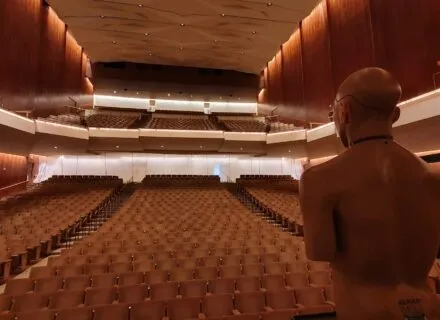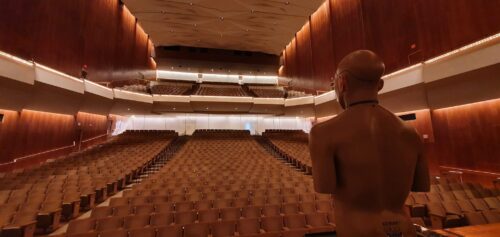part 1
By Mariana Seda
Singers have known for millennia that the acoustics of a performance space can affect how they perceive their sound and how they perform. But until recently, this understanding has been primarily anecdotal.
Yvonne Redman, faculty for Voice Performance at the School of Music, and a long-time main stage soprano at the Metropolitan Opera, was curious about the lack of research on how room acoustics can influence a singer’s voice production.
Like most musicians, vocalists sometimes rehearse in basements, bedrooms, even storage closets—spaces that are very different from performance venues.

“Oftentimes, performers rehearse in these odd places and become accustomed to their sound perceptions and level of vocal effort, but when they are in a new space (often a larger performance space) then they may feel the need to adjust their performance. Most research on how musicians adjust to their environment focuses on instrumentalists. So, our question was: how might a vocalist shift their performance?”
part 2
Redman teamed up with Dr. Pasquale Bottalico, a professor of speech and hearing sciences at the College of Applied Health Sciences at Illinois, and Dr. Joshua Glasner, professor of speech and language pathology at Delaware Valley University, to explore this question. Dr. Bottalico’s expertise stems not only from his study of acoustics and sound measurement, but also from his training as an opera singer. Likewise, Dr. Glasner holds a PhD in Vocal Performance.
“Typically the acoustics of a theater is assessed considering the pattern between the stage and different locations in the audience,” explained Dr. Bottalico. Thanks to new technology and an innovative approach, “we were able to quantify the acoustic pattern between the mouth and the ears of a person on the stage.”
Focusing primarily on vibrato (a subtle pulsing of pitch) and intonation (pitch accuracy), the research team developed a study that could measure the variance of these key elements of singing by recording live singers in different spaces.
To conduct this comparative study with as much precision as possible, several singers need to perform in a variety of professional venues within a short time frame. This is a feat that requires travel, space coordination, and much expense. Unless, of course, they work on a campus like the U of I, that is home to multiple world-renowned facilities within walking distance of each other.

part 3
Leveraging the unique stages at the Krannert Center for the Performing Arts and Smith Memorial Hall, the research team recorded nine singers in five different performance spaces during the span of one evening. “This is truly an Illinois study, because here at this university we were able to develop a research project that is not only unique but is very special to our campus,” said Redman. “It highlights our incredible performance spaces that we are very proud of.”
After analyzing the recordings, the researchers learned that singers do accommodate their performance somewhat based on the levels of reverberation feedback in a space. Generally, if singers could hear themselves well (higher reverberation), they demonstrated better pitch accuracy and produced slower vibrato. In spaces with less reverberation, singers sped up vibrato and sang louder, both indications of more vocal effort.
So, how can these findings help singers train and improve performance? For one, this research can help design performance spaces by considering the acoustic preferences of singers in addition to the audience. “This is all a very new and unique perspective. Most acousticians use studies that focus on audience perception to design spaces but very little is known about the performer’s perspective,” said Redman.
From a teaching perspective, instructors can use this information to explain to students what they may be able to expect from a space, how to be aware of its influence, and perhaps how to avoid changing their physical delivery based on the changes they perceive.
“Singing is a physical activity. It is really muscular training like any other athletic training—you just can’t see it as obviously as a track star,” said Redman. “If you go to each new space and your perception is radically changed, your production may be different than in practice, and your effort levels may rise and/or your tuning may change. It’s related to exercise physiology training.”
Now that the research team has quantitative evidence supporting their initial question—room acoustics can influence voice production—they want to see how that compares with singer perception. Currently, the team is collecting results for a qualitative study in which they interviewed the singers about their experiences and preferences in regard to each space.
The project exemplifies how fine and applied arts can collaborate with the sciences. “The beauty of a collaborative research project is that I can participate in a project that informs my field without needing to obtain a degree in hearing science or acoustics,” explained Redman. “I can just collaborate with experts, many on our own campus, who can then translate these findings both for my field and their own fields.”
The study, Singing in different performance spaces: The effect of room acoustics on vibrato and pitch inaccuracy, is published in The Journal of Acoustical Society of America.
